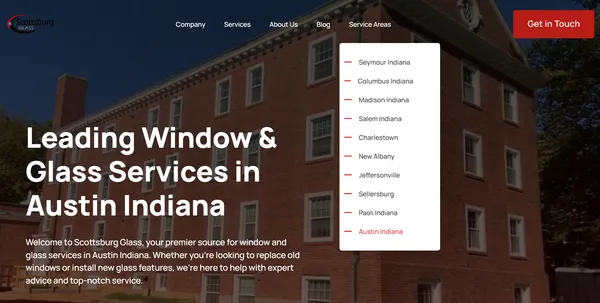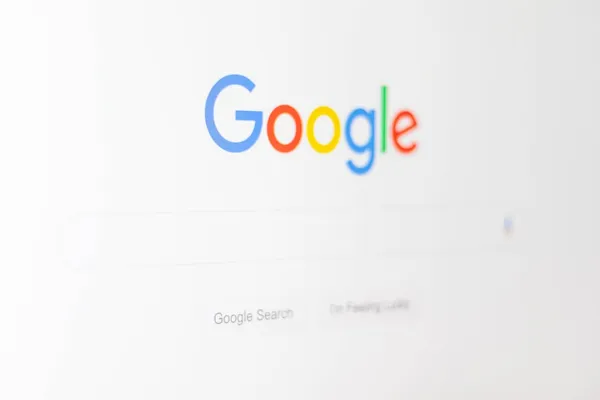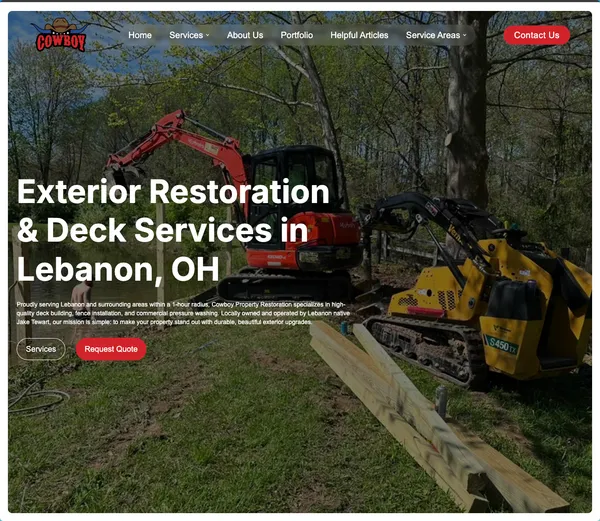
May 20, 2025
Forget Backlinks. Here’s How I Ranked a Glass Company #1 in a City They Don’t Even Live In.
Ever heard of Austin, Indiana? Neither had I, until a glass company owner told me she wanted his phones ringing from that area. Most people get scared off by the thought of SEO—imagining big budgets, flashy ads, or obsessive link building. Truth? I did none of that. I just built one really useful page and made it findable. Here’s exactly how it played out, plus what nobody tells you about showing up in Google for a city you barely know.Lesson #1: SEO Doesn't Need to Be FancyLet me bust a myth real quick: You don't need fancy SEO tactics to win online.When I helped that glass company, we started with what they already had - happy customers. That's gold most businesses would kill for!What did we actually do?Mapped their real service area (not just their home city)Created ONE hyper-relevant page for Austin, IndianaSkipped expensive link-building nonsenseAdded honest information that helped customersWe didn't overthink it. We didn't chase the latest SEO theory or buy fancy tools.The results? #1 ranking within weeks. Zero backlinks required.Most businesses already have everything they need - they just need to show Google where they actually work. Start where you're already winning locally and build from there.The Power of the Radius: Why I Mapped Customer Distance Before I Wrote a WordBefore touching a keyboard, I asked one simple question: "How far do your customers actually drive?"The answer shocked me.Most customers traveled way beyond city limits to get their glass fixed. This wasn't just interesting—it was a goldmine of opportunity.Instead of blindly targeting keywords, I mapped where their vans actually drove each week. Reality hit me: city boundaries are meaningless to customers who just need service.So I looked for gaps in their service radius. Hello, Austin, Indiana—a spot nobody else was targeting!Why waste effort building pages for cities nobody calls from? One strategic location page beats a shotgun approach every time.I added a simple map showing their real service area on the page. It wasn't just SEO—it was showing potential customers: "Yes, we'll come to you."The wheels hit the road... and so did the rankings.Forget "Backlinks"—Build Something People Want to ClickI didn't waste time buying backlinks or sending those awkward "can you link to me?" emails. Nope.Instead, I built a page that actually answered questions people in Austin, Indiana had about glass services:"Have you fixed windows in my neighborhood before?""How quickly can you get here from your location?""What's the cost for standard window repairs?"I wrote everything for humans, not algorithms. Added a map, clear contact details, and straightforward service descriptions.Google noticed. Why? Because real people were clicking and staying.The proof? Just two weeks after launch (with zero backlinks built), I got this email:"Hey, I found you from Austin—can you fix my cracked window?"That's it. No SEO magic tricks. Just content that converts because it helps actual people.Manual Indexing: The Part They Never Tell You AboutHere's something they don't mention in fancy SEO courses: Google doesn't always notice your new pages. Especially for small local businesses.What did I do? I manually submitted the Austin location page for indexing. Takes literally five minutes but makes a massive difference.Why don't most "experts" talk about this? No idea. It's stupidly simple and practical.The ProcessLog into Google Search ConsoleSubmit URL for indexingWait for Google to crawl itThe results? After submitting, Google crawled the page almost immediately. And in under 3 weeks, they hit the #1 spot.Stuck waiting for your page to rank? Try manual indexing—especially for smaller cities where competition is lighter.And no, "manual" doesn't mean complicated. It's just filling out a form. Sometimes the simplest tricks work best.Wild Card: What If I'd Gone the Ad Route or Tried to Game the System?Let's play a hypothetical game for a second.I could've burned through my client's cash on Google Ads targeting Austin. Sure, they'd get calls—until the money dried up. Then what? Complete visibility drop-off.Or maybe I could've built sketchy backlinks. Perhaps created fake service history in the area?But here's the reality: one honest page worked faster and cost nothing.If I'd gone the ad route, that first lead probably would've cost $50+. And the second their budget paused—poof! Back to digital invisibility.Even spending $100/month wouldn't guarantee actual engagement or loyalty. Just impressions and maybe some clicks.Glass companies don't need SEO tricks. They need customers who find them when searching for solutions, then trust what they see.No ads. No backlinks. Just service area relevance and a clear call to action.Conclusion: Simplicity Beat the Hustle—Here's How You Can Do It TooI've shown you exactly how I took a glass company to #1 in a city they don't even live in—with zero backlinks, zero ads, and just one focused service area page.Here's the magic: I kept it ridiculously simple.Don't overcomplicate things. Build one service area page, then actually map your real radius before chasing big-city dreams. Speak like a human—potential customers want answers, not SEO buzzwords.The basics work. Manual indexing. Clear contact info. Real details about your service. These fundamentals got results in just 3 weeks flat.This isn't exclusive to glass repair. Any blue-collar business can do this—plumbers, roofers, electricians. You name it.You don't need a marketing degree or complicated strategies. Just basic honesty and the guts to execute.Try it for your real service areas. One page at a time. Watch what happens.TL;DR: Skip the SEO circus act. I made a plain location page for a glass company, focused on where customers actually come from, and landed them the top spot without paid ads or tricky backlinks. If you want real results, focus on how people search—not on what digital ‘gurus’ try to sell you.Schedule a call with me
5 Minutes Read

May 16, 2025
How I Decided Whether Local SEO Was Worth It for My Ohio Biz (And How You Can Too)
I still remember the first time I spent hours optimizing my site for Google Maps—updating every obscure setting and crafting pages for every suburb from Lebanon to Springboro. Then, when the results trickled in, I realized some tactics paid off while others felt like tossing coins into a wishing well. If you’ve ever wondered if all this local SEO stuff is worth your time for your Ohio business (or if you’re just searching for a smarter strategy in 2025), grab a coffee. I’ve crunched the numbers, checked the competition, and I’m not shy to share what really worked (or what made me scratch my head). Learning from the Competition: Real Numbers, Real Surprises When I first considered investing in local SEO for my Ohio business, I made a classic mistake. I obsessed over ranking #1 for the most obvious keywords. Big mistake. What changed my approach? I got nosy about my competition. What's Really Driving Their Traffic? I decided to look up my top competitor in Lebanon (and later another in Mason) to see what was actually bringing them web traffic. The results shocked me. Using SEMrush (though Keywords Everywhere works too), I analyzed their traffic sources. Guess what? 36% of their traffic came from branded searches—people typing their business name + location A whopping 60-70% total traffic came from people who already knew who they were Only 6% came from primary service keywords I'd been obsessing over This completely shifted my perspective. I'd been planning to create dozens of location pages targeting every suburb around Springboro, Lebanon, and Mason. But was that really the best use of my resources? The Keywords That Actually Matter Here's the thing about local SEO that nobody tells you—the keywords driving actual business aren't always the obvious ones. In my research across several med spas in southwestern Ohio, I discovered Google Maps visibility drove far more new leads than fancy blog posts or location pages. Go figure! "If you know that on average your web pages convert 4% of the time... is it in your best interest to create a page?" – Chris Palmer That quote hit me hard. Let's do some simple math: If a keyword gets 40 clicks/month and costs $12 per click via ads Your pages convert at the average 4% rate That's just 1-2 conversions monthly from a page that might take weeks to rank Is that worth the investment? Sometimes yes, sometimes no—but at least now I had real data to decide! How to Legally "Spy" on Your Competition Want to do this yourself? It's surprisingly easy: Identify your top local competitor in places like Lebanon or Mason Use SEMrush or Keywords Everywhere to analyze their traffic Look specifically for branded vs. non-branded terms Note which service+location terms actually bring them traffic Just remember—the goal isn't to blindly copy competitors. It's to understand where they're actually getting results and decide if similar approaches make sense for your business. In my case, I completely reallocated my resources based on these findings. Instead of chasing low-traffic keywords across dozens of Ohio suburbs, I focused on building brand recognition and optimizing Google Maps presence—where the real action was happening.Don't Just Build Pages—Calculate If They're Worth It I fell into that trap. You know the one - creating endless location pages because "that's what you do" for local SEO. "Mason hair removal," "Springboro HVAC," "Lebanon pest control" - I was building them all without stopping to ask a simple question: was it actually worth it? Let me break down what this actually costs: Page creation: About $40 (and that's being conservative) Basic SEO optimization: Another $50 Link building: At least $100 per page That's $190 minimum per location page - and I haven't even factored in my own time! As a business owner, I had to get real about the math. The Brutal Math of Local Pages Here's what I learned the hard way. If I'm selling a $500 service, and a new location page only brings in 1-2 extra customers per year... sometimes it's just not worth it. "My own pages sometimes took hours to write and promote, but only moved the needle when the keyword brought real traffic." I had to ask myself with brutal honesty - could my time and money be better spent elsewhere? Often, the answer was yes. Every Ohio Town Is Different What's fascinating? Even nearby towns can show completely different ROI. A page targeting Mason might bring in consistent business, while one for Springboro (just minutes away) barely registers a blip. For example, my Lebanon page converted at 4% while Deer Park was under 1%. Same service, same distance from my business - wildly different results. Calculate Before You Create Before you build your next location page, do this quick analysis: Check what traffic you might realistically get (tools like SEMrush can help) Calculate your total investment (page creation + optimization + links + YOUR TIME) Estimate conversion rate (be conservative) Multiply by your average service value Is the math favorable? Great! If not... put your resources elsewhere. The Hidden Cost We All Forget The biggest mistake I made? Ignoring the opportunity cost of my own time. Those hours spent creating a page for "Iverness window cleaning" could have gone toward building better systems, training staff, or just taking a break! Ask yourself: What else could I do with these 5-10 hours that might bring a better return? Sometimes the smartest strategy isn't creating more pages - it's making your existing ones work harder or focusing on the locations that already show promise.When to Bet Big on Google Maps (And When Not To) I've seen it firsthand in my Ohio business journey - some local companies in Springboro absolutely crush it in the Google Maps "Map Pack" while others barely make a dent. The difference in lead generation is night and day. How I Figured Out If Maps Was Worth My Investment Last year, I was debating whether to pour resources into my Google Business Profile or focus elsewhere. The answer wasn't obvious at first. So I did what any curious business owner would do - I stalked my competition. Not literally, of course! 😉 Using SEMrush (though any similar tool works), I analyzed top competitors in Mason and Lebanon. The results were eye-opening. "This tells you that whatever your keywords are... you're probably doing something different than what I'm showing, but what I am showing you is that when you put in your leading competition… you can see that the traffic that's coming in for this keyword is because they're in the map pack." – Chris Palmer When to Double Down on Maps After digging through the data, I discovered three scenarios where investing in Google Maps makes absolute sense: When your competitors dominate the Map Pack - If they're getting significant traffic from Maps for your target keywords, that's where the customers are looking. For hyper-local services - Especially in smaller Ohio towns like Lebanon and Springboro where "near me" searches are common. If you serve multiple areas - Being in the Map Pack for "Med Spa Lebanon" can drive more awareness than a dozen blog posts. I found that optimizing my service areas, consistently posting updates, and aggressively pursuing reviews moved the needle significantly in Mason. When Maps Might Not Be Worth It But here's the thing - Maps isn't always the golden ticket. I learned this the hard way. If your main competitors' traffic is mostly from: Direct name searches (brand recognition) Services different from what you're targeting Organic search results below the Map Pack Then you might want to reconsider your approach. The Surprising Reality Check One thing that shocked me? Sometimes the most clicked service isn't what I expected! For example, one Springboro business I studied ranked for "med spa" but got most of their traffic from "botox treatments" - which wasn't even their main service! Check the actual search data before investing. I've seen businesses in Lebanon dominate by focusing on very specific service+location combinations rather than generic terms. Bottom line: if your competitors are killing it in the Map Pack with similar services to yours, that's where you need to be. But if not, your marketing dollars might be better spent elsewhere.Wild Card Wisdom: Making the Final Call (Plus, a Tangent on Mailers) I've spent way too many hours going down the SEO rabbit hole for my Lebanon hardware store. And if there's one thing I've learned? There's no magic formula. Seriously. Some days I feel like throwing my laptop out the window. Reverse-Engineer What Actually Works Here's my honest take: stop chasing what everyone says you "should" be doing. Instead, I've found success by reverse-engineering what's already working in my specific market. As SEO expert Chris Palmer points out: "This gives us another clue... what other type of marketing are they doing? Are they dropping mail? Are they running PPC?" That's the million-dollar question right there! When my competitor in Springboro was suddenly crushing it online, I did some digging. Turns out they weren't just ranking on Google—they were dropping direct mail pieces all over town. Old-School + New-School = Smart Business Here's something weird I discovered by accident: those "outdated" marketing tactics can actually supercharge your SEO efforts. How? By driving branded searches. When people see your flyer, postcard, or newspaper ad, they don't always call the number. Many grab their phone and Google you instead. Those branded searches? Pure gold for your SEO juice. The Mason Flyer Miracle Quick story: My friend Julie runs a small bakery in Mason. Last summer, she was struggling to get traction online despite having a beautiful website. Her solution wasn't some fancy SEO package. She printed 5,000 colorful flyers highlighting her website URL and distributed them at community events. The result? Her branded search traffic doubled within three weeks. Her Google Business Profile views shot up 78%. It wasn't rocket science—just smart, local marketing that acknowledged how Mason residents actually discover new businesses. Final Thoughts: Stay Nimble, Stay Local What works in Cincinnati might flop in Springboro. What drives traffic in Lebanon could be crickets in Middletown. Each Ohio community has its own quirks. My biggest advice? Test both digital and traditional approaches, then double down on what delivers results for YOUR specific situation. Sometimes that means embracing seemingly contradictory strategies—like using paper mailers to boost digital performance. The SEO landscape keeps shifting, but understanding your local market never goes out of style. And that, my fellow Ohio business owners, is something I wish someone had told me years ago. Has your business found success with an unexpected marketing approach? I'd love to hear about it in the comments!TL;DR: You don’t have to guess where your local SEO dollars are best spent—look at what’s actually driving clicks for your local competitors, then focus your resources there. Request a call today
10 Minutes Read
